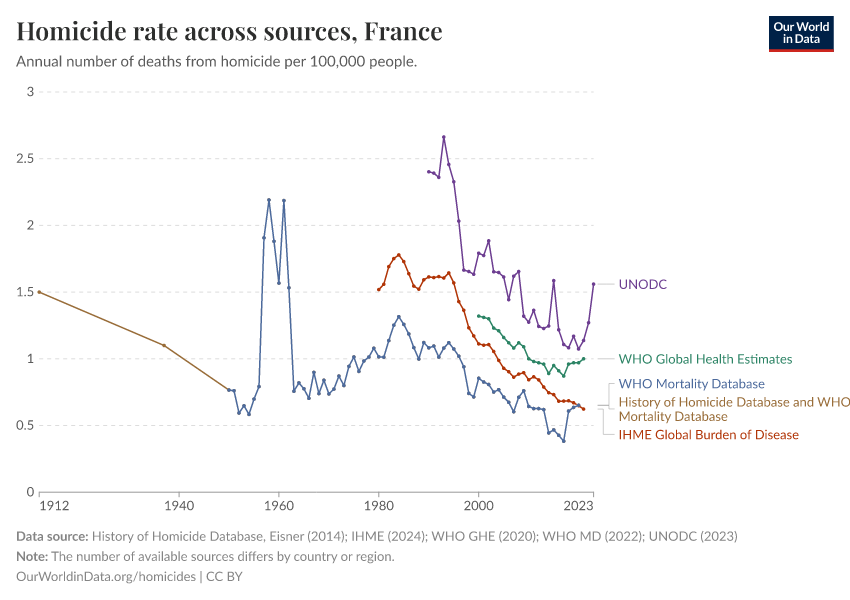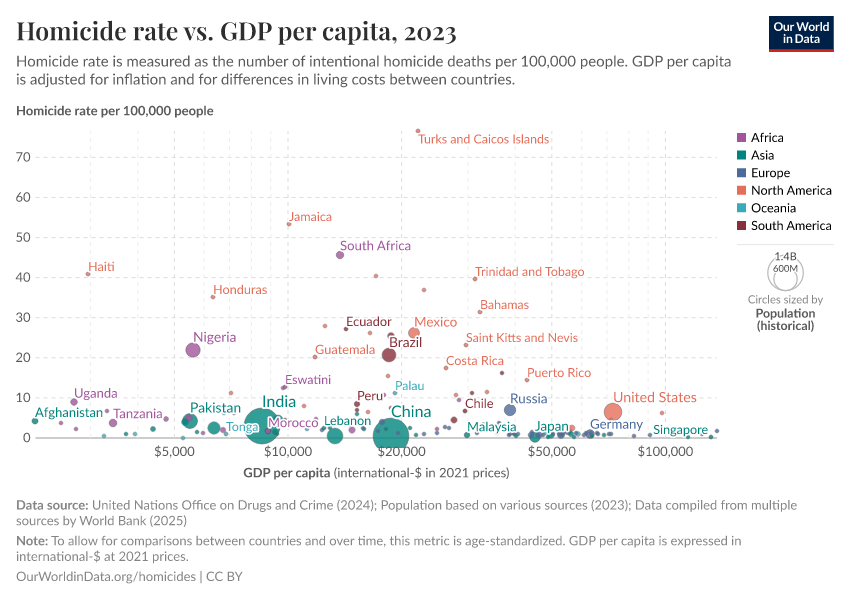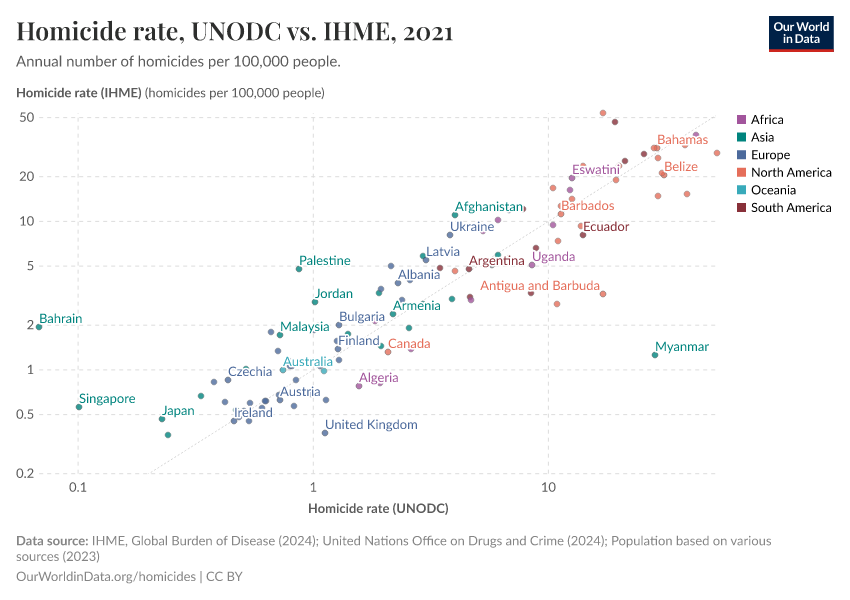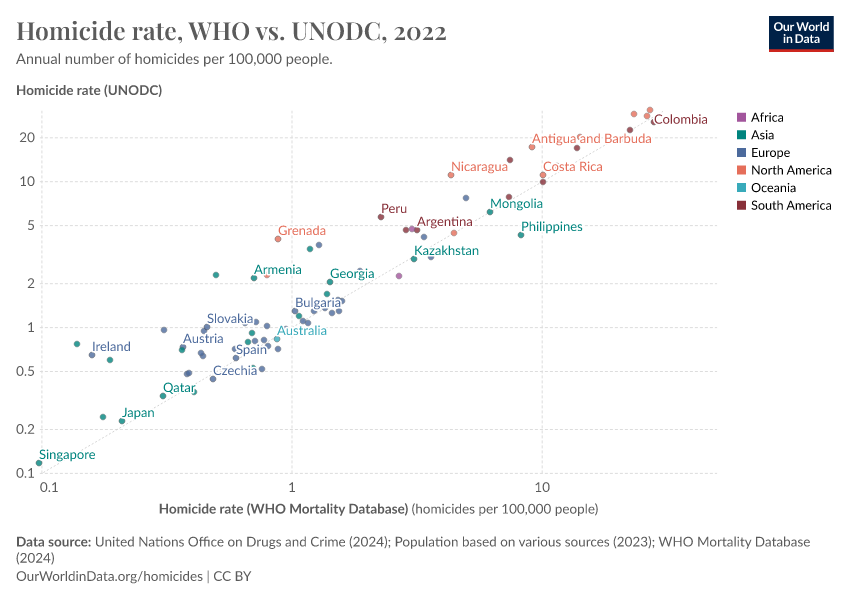Homicide rate per 100,000 population
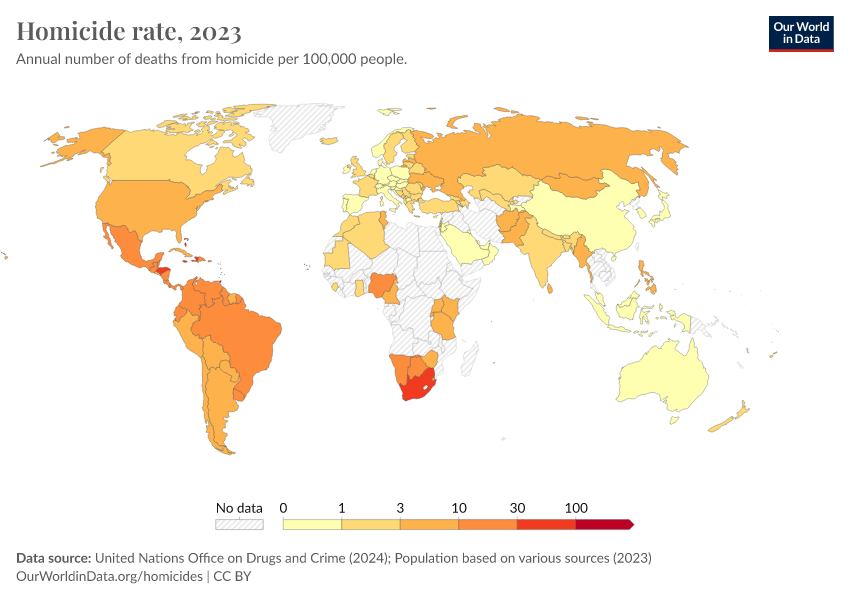
What you should know about this indicator
- UNODC collects intentional homicide data from criminal justice systems (law enforcement records) and public health systems (death certificates).
- Intentional homicide requires three elements: one person killing another, intent to kill or seriously injure, and the act was illegal. For example, a person who kills another in self-defence is not considered to have committed an intentional homicide as justifiable homicide in self-defence is not illegal.
- All killings that meet the criteria listed below are to be considered intentional homicides, irrespective of definitions provided by national legislations or practices.
- Terrorist killings are included as intentional homicides.
Related research and writing
What you should know about this indicator
- UNODC collects intentional homicide data from criminal justice systems (law enforcement records) and public health systems (death certificates).
- Intentional homicide requires three elements: one person killing another, intent to kill or seriously injure, and the act was illegal. For example, a person who kills another in self-defence is not considered to have committed an intentional homicide as justifiable homicide in self-defence is not illegal.
- All killings that meet the criteria listed below are to be considered intentional homicides, irrespective of definitions provided by national legislations or practices.
- Terrorist killings are included as intentional homicides.
Sources and processing
This data is based on the following sources
How we process data at Our World in Data
All data and visualizations on Our World in Data rely on data sourced from one or several original data providers. Preparing this original data involves several processing steps. Depending on the data, this can include standardizing country names and world region definitions, converting units, calculating derived indicators such as per capita measures, as well as adding or adapting metadata such as the name or the description given to an indicator.
At the link below you can find a detailed description of the structure of our data pipeline, including links to all the code used to prepare data across Our World in Data.
Notes on our processing step for this indicator
Values for the United Kingdom are calculated by Our World in Data from UNODC data for England, Wales, Scotland and Northern Ireland.
Rates for the most recent year are calculated using medium population projection estimates from the United Nations World Population Prospects.
Reuse this work
- All data produced by third-party providers and made available by Our World in Data are subject to the license terms from the original providers. Our work would not be possible without the data providers we rely on, so we ask you to always cite them appropriately (see below). This is crucial to allow data providers to continue doing their work, enhancing, maintaining and updating valuable data.
- All data, visualizations, and code produced by Our World in Data are completely open access under the Creative Commons BY license. You have the permission to use, distribute, and reproduce these in any medium, provided the source and authors are credited.
Citations
How to cite this page
To cite this page overall, including any descriptions, FAQs or explanations of the data authored by Our World in Data, please use the following citation:
“Data Page: Homicide rate per 100,000 population”, part of the following publication: Bastian Herre, Fiona Spooner, and Max Roser (2013) - “Homicides”. Data adapted from United Nations Office on Drugs and Crime, United Nations, Various sources. Retrieved from https://archive.ourworldindata.org/20260105-133053/grapher/homicide-rate-unodc.html [online resource] (archived on January 5, 2026).How to cite this data
In-line citationIf you have limited space (e.g. in data visualizations), you can use this abbreviated in-line citation:
UN, World Population Prospects (2024); United Nations Office on Drugs and Crime (2025) – with major processing by Our World in DataFull citation
UN, World Population Prospects (2024); United Nations Office on Drugs and Crime (2025) – with major processing by Our World in Data. “Homicide rate per 100,000 population” [dataset]. United Nations Office on Drugs and Crime, “United Nations Office on Drugs and Crime - Intentional Homicide Victims”; United Nations, “World Population Prospects”; Various sources, “Population” [original data]. Retrieved January 7, 2026 from https://archive.ourworldindata.org/20260105-133053/grapher/homicide-rate-unodc.html (archived on January 5, 2026).